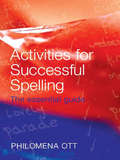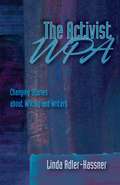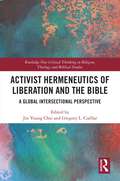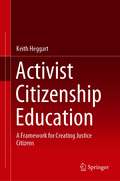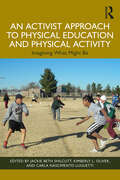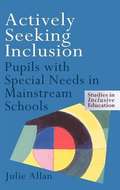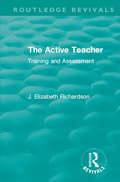- Table View
- List View
Activities for Using the Internet in Primary Schools
by De Cicco, Eta Farmer, Mike (Senior Lecturer, University of Central England) Hargrave, ClaireThis text guides primary staff to Internet sites of value to the national curriculum Key Stages 1 and 2 offering appropriate ways of using ICT in the classroom. It contains practical activities, information and advice on developing and supporting class activities.
Activities for Using the Internet in Primary Schools
by De Cicco, Eta Farmer, Mike (Senior Lecturer, University of Central England) Hargrave, ClaireThis text guides primary staff to Internet sites of value to the national curriculum Key Stages 1 and 2 offering appropriate ways of using ICT in the classroom. It contains practical activities, information and advice on developing and supporting class activities.
Activities for Teaching Citizenship in Secondary Schools: Lesson Plans Across the Curriculum
by Baker, Patricia Turner, DavidA resource for teachers wishing to develop citizenship in their teaching activities. It provides activities for use in teaching, and includes lesson plans, photocopiable work sheets and guides to further resources.
Activities for Teaching Citizenship in Secondary Schools: Lesson Plans Across the Curriculum
by Baker, Patricia Turner, DavidA resource for teachers wishing to develop citizenship in their teaching activities. It provides activities for use in teaching, and includes lesson plans, photocopiable work sheets and guides to further resources.
Activities for Successful Spelling: The Essential Guide
by Philomena OttThis highly practical activity workbook is linked to the core text How to Manage Spelling Successfully and has been designed to support dyslexic students practise the spelling strategies and methods recommended in that book. This activity book can be used separately, or as part of an integrated programme for building students' spelling skills at home or at school. Suitable for mainstream classrooms, pupils undertaking additional literacy support in small groups, and for one-to-one teaching of individuals with specific learning difficulties including dyslexia, this excellent resource contains activities suitable for use at different stages of development, and for use with adults as well as school students. Each section contains a range of multi-sensory activities, including word searches, simple crossword puzzles and dictation exercises. This is an essential classroom companion for anyone helping struggling spellers.
Activities for Successful Spelling: The Essential Guide
by Philomena OttThis highly practical activity workbook is linked to the core text How to Manage Spelling Successfully and has been designed to support dyslexic students practise the spelling strategies and methods recommended in that book. This activity book can be used separately, or as part of an integrated programme for building students' spelling skills at home or at school. Suitable for mainstream classrooms, pupils undertaking additional literacy support in small groups, and for one-to-one teaching of individuals with specific learning difficulties including dyslexia, this excellent resource contains activities suitable for use at different stages of development, and for use with adults as well as school students. Each section contains a range of multi-sensory activities, including word searches, simple crossword puzzles and dictation exercises. This is an essential classroom companion for anyone helping struggling spellers.
Activities for Individual Learning through Shape and Colour: Resources for the Early Years Practitioner
by Wendy BowkettContaining over 70 tried-and-tested activities, Activities for Individual Learning through Shape and Colour is a practical resource which takes a cross-curricular thematic approach and uses the themes of shape and colour to explore the Early Years Foundation Stage (EYFS). This thematic approach saves preparation and teaching time for practitioners and provides children with more effective and engaging activities. It also familiarises children with the more sophisticated cross-curricular projects they will encounter in the primary school. Activities are clustered around particular shapes and colours and each set of activities is clearly linked to the EYFS Early Learning Goals.Activities for Individual Learning through Shape and Colour is a highly practical invaluable resource book for all early years practitioners.
Activities and Exercises for Teaching English Pronunciation
by Adam BrownThis book is a practical, comprehensive tool for busy teachers or educators teaching English pronunciation. Brown puts pronunciation into perspective with other aspects of language, highlighting the importance of teaching pronunciation from the start. Applicable for both British and American pronunciation, this book is organized by aspects of pronunciation and includes a wealth of photocopiable worksheets to use in the classroom. The engaging exercises include rhymes, games, puzzles, narratives, and more, all designed to promote learner engagement and understanding. Each worksheet is accompanied by supplementary resources and guidance, including recommendations for modifying lessons for different English learner proficiency levels; instructions for the teacher and learners; correct or expected answers; and tips for teachers to extend and create their own exercises. The versatility and adaptability of this book make it a beneficial resource for teachers of ESL/EFL/EAL, as well as educational professionals who consult and oversee teacher trainer programs and courses in TESOL.
Activities and Exercises for Teaching English Pronunciation
by Adam BrownThis book is a practical, comprehensive tool for busy teachers or educators teaching English pronunciation. Brown puts pronunciation into perspective with other aspects of language, highlighting the importance of teaching pronunciation from the start. Applicable for both British and American pronunciation, this book is organized by aspects of pronunciation and includes a wealth of photocopiable worksheets to use in the classroom. The engaging exercises include rhymes, games, puzzles, narratives, and more, all designed to promote learner engagement and understanding. Each worksheet is accompanied by supplementary resources and guidance, including recommendations for modifying lessons for different English learner proficiency levels; instructions for the teacher and learners; correct or expected answers; and tips for teachers to extend and create their own exercises. The versatility and adaptability of this book make it a beneficial resource for teachers of ESL/EFL/EAL, as well as educational professionals who consult and oversee teacher trainer programs and courses in TESOL.
Activist WPA, The: Changing Stories About Writing and Writers
by Linda Adler-KassnerOne wonders if there is any academic field that doesn’t suffer from the way it is portrayed by the media, by politicians, by pundits and other publics. How well scholars in a discipline articulate their own definition can influence not only issues of image but the very success of the discipline in serving students and its other constituencies. The Activist WPA is an effort to address this range of issues for the field of English composition in the age of the Spellings Commission and the No Child Left Behind Act. Drawing on recent developments in framing theory and the resurgent traditions of progressive organizers, Linda Adler-Kassner calls upon composition teachers and administrators to develop strategic programs of collective action that do justice to composition’s best principles. Adler-Kassner argues that the “story” of college composition can be changed only when writing scholars bring the wonders down, to articulate a theory framework that is pragmatic and intelligible to those outside the field--and then create messages that reference that framework. In The Activist WPA, she makes a case for developing a more integrated vision of outreach, English education, and writing program administration.
Activist Science and Technology Education (Cultural Studies of Science Education #9)
by John Bencze Steve AlsopThis collection examines issues of agency, power, politics and identity as they relate to science and technology and education, within contemporary settings. Social, economic and ecological critique and reform are examined by numerous contributing authors, from a range of international contexts. These chapters examine pressing pedagogical questions within socio-scientific contexts, including petroleum economies, food justice, health, environmentalism, climate change, social media and biotechnologies. Readers will discover far reaching inquiries into activism as an open question for science and technology education, citizenship and democracy. The authors call on the work of prominent scholars throughout the ages, including Bourdieu, Foucault, Giroux, Jasanoff, Kierkegaard, Marx, Nietzsche, Rancière and Žižek. The application of critical theoretical scholarship to mainstream practices in science and technology education distinguishes this book, and this deep, theoretical treatment is complemented by many grounded, more pragmatic exemplars of activist pedagogies. Practical examples are set within the public sphere, within selected new social movements, and also within more formal institutional settings, including elementary and secondary schools, and higher education. These assembled discussions provide a basis for a more radically reflexive reworking of science and technology education. Educational policy makers, science education scholars, and science and technology educators, amongst others, will find this work thought-provoking, instructive and informative.
Activist Hermeneutics of Liberation and the Bible: A Global Intersectional Perspective (Routledge New Critical Thinking in Religion, Theology and Biblical Studies)
by Jin Young Choi Gregory L. CuéllarInspired by the current political moment around the globe in which uprisings, protests, revolutions, and movements are on the rise, this book examines the intersections between the Bible and activism. It does this by showcasing intersectional readings of the Bible as an activist act and a tool for activism; historicizing the uses of the Bible within activist/freedom movements around the globe; and offering activist approaches to teaching the Bible.Each chapter in this volume provides a critical and substantive response from the discipline of Biblical Studies to global political trends. International in scope, with contributors from Africa, Asia, Caribbean, Europe, Latin America, Oceania and the United States, they address themes such as gender politics, racial injustices, violence toward women, political resistance, and activist hermeneutics and pedagogies. Together they harness the intellectual energies of minoritized Biblical scholars in a nonessentialist manner to reflect on the Bible as a tool for liberating social and political change. Reflecting on the activist potential of the Bible, this book will be of keen interest to scholars in Biblical Studies, Political Theology, and Religious Studies.
Activist Hermeneutics of Liberation and the Bible: A Global Intersectional Perspective (Routledge New Critical Thinking in Religion, Theology and Biblical Studies)
by Jin-Young Choi Gregory L. CuéllarInspired by the current political moment around the globe in which uprisings, protests, revolutions, and movements are on the rise, this book examines the intersections between the Bible and activism. It does this by showcasing intersectional readings of the Bible as an activist act and a tool for activism; historicizing the uses of the Bible within activist/freedom movements around the globe; and offering activist approaches to teaching the Bible.Each chapter in this volume provides a critical and substantive response from the discipline of Biblical Studies to global political trends. International in scope, with contributors from Africa, Asia, Caribbean, Europe, Latin America, Oceania and the United States, they address themes such as gender politics, racial injustices, violence toward women, political resistance, and activist hermeneutics and pedagogies. Together they harness the intellectual energies of minoritized Biblical scholars in a nonessentialist manner to reflect on the Bible as a tool for liberating social and political change. Reflecting on the activist potential of the Bible, this book will be of keen interest to scholars in Biblical Studies, Political Theology, and Religious Studies.
Activist Educators: Breaking Past Limits (Teaching/Learning Social Justice)
by Catherine Marshall Amy L. AndersonTaking an active stand in today's conservative educational climate can be a risky business. Given both the expectations of the profession and the challenge of participation in social justice activism, how do educator activists manage the often competing demands of professional and activist commitments? Activist Educators offers a view into the big picture of assertive idealistic professionals’ lives by presenting rich qualitative data on the impetus behind educators’ activism and the strategies they used to push limits in fighting for a cause. Chapters follow the stories of educator activists as they take on problems in schools, including sexual harassment, sexism, racism, reproductive rights, and GLBT rights. The research in Activist Educators contributes to an understanding of professional and personal motivations for educators’ activism, ultimately offering a significant contribution to aspiring teachers who need to know that education careers and social justice activist causes need not be mutually exclusive pursuits.
Activist Educators: Breaking Past Limits (Teaching/Learning Social Justice)
by Catherine Marshall Amy L. AndersonTaking an active stand in today's conservative educational climate can be a risky business. Given both the expectations of the profession and the challenge of participation in social justice activism, how do educator activists manage the often competing demands of professional and activist commitments? Activist Educators offers a view into the big picture of assertive idealistic professionals’ lives by presenting rich qualitative data on the impetus behind educators’ activism and the strategies they used to push limits in fighting for a cause. Chapters follow the stories of educator activists as they take on problems in schools, including sexual harassment, sexism, racism, reproductive rights, and GLBT rights. The research in Activist Educators contributes to an understanding of professional and personal motivations for educators’ activism, ultimately offering a significant contribution to aspiring teachers who need to know that education careers and social justice activist causes need not be mutually exclusive pursuits.
Activist Citizenship Education: A Framework for Creating Justice Citizens
by Keith HeggartThis book explores alternative models of civics and citizenship education. Specifically, it uses Justice Citizens, a participatory research and film-making project, as a tool to examine young people’s ideas about active citizenship and participation in public spaces. It introduces a framework that seeks to explore the diverse and apparently contradictory nature of young people’s active citizenship. The framework draws on complexity theory combined with critical pedagogy and democratic education to formulate an approach to developing active citizenship among young people. This approach extends theories of both critical pedagogy and education for citizenship, and by doing so seeks to explain the variegated nature of young people’s engagement with civil society. This book contains a valuable repository of ideas and resources for application for teachers to use in schools and classrooms. Academics engaged in initial teacher education, at both primary and secondary levels, will find the framework of use when describing the importance and new approaches to civics and citizenship education within the current school and policy environments.
An Activist Approach to Physical Education and Physical Activity: Imagining What Might Be
by Jackie Beth Shilcutt Kimberly L. Oliver Carla Nascimento LuguettiThis timely and diverse collection offers perspectives on engaging people in physical activity utilizing the Activist Approach. This approach facilitates interest, motivation, and learning in physical education by focusing on student-centered pedagogy, embodiment, inquiry-based education, and listening and responding to students over time. The resource collates experts and beginners who have used the Activist Approach to incorporate participants’ interests, motivation, and learning needs and maintain student voices in physical activity environments. Chapters center around three broad areas of the Activist Approach: 1) physical education settings, 2) physical activity settings, and 3) teachers’ experiences of learning to use an Activist Approach in physical education and physical activity. Contributors from around the world discuss challenges and benefits experienced, issues of equity and justice and what people gained and gave up by using the approach. Focusing on key areas in physical education settings, dance, sport, and physical activity settings, and PE teacher education and professional development, this book offers crucial, critical perspectives on how to meet people’s physical activity needs.
An Activist Approach to Physical Education and Physical Activity: Imagining What Might Be
This timely and diverse collection offers perspectives on engaging people in physical activity utilizing the Activist Approach. This approach facilitates interest, motivation, and learning in physical education by focusing on student-centered pedagogy, embodiment, inquiry-based education, and listening and responding to students over time. The resource collates experts and beginners who have used the Activist Approach to incorporate participants’ interests, motivation, and learning needs and maintain student voices in physical activity environments. Chapters center around three broad areas of the Activist Approach: 1) physical education settings, 2) physical activity settings, and 3) teachers’ experiences of learning to use an Activist Approach in physical education and physical activity. Contributors from around the world discuss challenges and benefits experienced, issues of equity and justice and what people gained and gave up by using the approach. Focusing on key areas in physical education settings, dance, sport, and physical activity settings, and PE teacher education and professional development, this book offers crucial, critical perspectives on how to meet people’s physical activity needs.
Actively Seeking Inclusion: Pupils With Special Needs In Mainstream Schools
by Julie AllanA study of the ways in which special needs students are treated by mainstream educational institutions and how those ways can and need to be changed.
Actively Seeking Inclusion: Pupils with Special Needs in Mainstream Schools (Studies In Inclusive Education Ser.)
by Julie AllanFirst Published in 2004. Routledge is an imprint of Taylor & Francis, an informa company.
Actively Seeking Inclusion: Pupils with Special Needs in Mainstream Schools
by Julie AllanFirst Published in 2004. Routledge is an imprint of Taylor & Francis, an informa company.
Active Training: A Handbook of Techniques, Designs, Case Examples, and Tips (Active Training Series #12)
by Melvin L. Silberman Elaine BiechThe all-time bestselling training handbook, updated for new technologies and roles Active Training turns instructional design on its head by shifting the emphasis away from the instructor, and on to the learner. Comprehensively updated to reflect the many developments in the field, this new fourth edition covers the latest technologies and applications, the evolving role of the trainer, and how new business realities impact training, advancing new evidence-based best practices for new trainer tasks, skills, and knowledge. Up to date theory and research inform the practical tips and techniques that fully engage learners and help them get the most out of sessions, while updated workplace examples and revised templates and worksheets help bring these techniques into the classroom quickly. You'll gain insight into improving training evaluation by using Return on Expectations (ROE), learn how to extend the value of training programs through transfer of learning, and develop fresh, engaging methods that incorporate state-of-the-art applications. Active Training designs offer just the right amount of content; the right balance of affective, behavioral, and cognitive learning; a variety of approaches; real-life problem solving; gradual skill-building; and engaging delivery that uses the participants' expertise as a foundation for learning. This book is the classic guide to employing Active Training methods effectively and appropriately for almost any topic. Learn how the trainer's role has changed Engage learners through any training delivery method Inspire collaboration and innovation through application Overcome the challenges trainers face in the new business environment Active Training methods make training sessions fun, engaging, relevant, and most importantly, effective. Participants become enthusiastic about the material, and view sessions as interesting challenges rather than as means to fulfill requirements. To bring these widely endorsed methods into your training repertoire, Active Training is the complete practical handbook you need.
Active Training: A Handbook of Techniques, Designs, Case Examples, and Tips (Active Training Series)
by Melvin L. Silberman Elaine BiechThe all-time bestselling training handbook, updated for new technologies and roles Active Training turns instructional design on its head by shifting the emphasis away from the instructor, and on to the learner. Comprehensively updated to reflect the many developments in the field, this new fourth edition covers the latest technologies and applications, the evolving role of the trainer, and how new business realities impact training, advancing new evidence-based best practices for new trainer tasks, skills, and knowledge. Up to date theory and research inform the practical tips and techniques that fully engage learners and help them get the most out of sessions, while updated workplace examples and revised templates and worksheets help bring these techniques into the classroom quickly. You'll gain insight into improving training evaluation by using Return on Expectations (ROE), learn how to extend the value of training programs through transfer of learning, and develop fresh, engaging methods that incorporate state-of-the-art applications. Active Training designs offer just the right amount of content; the right balance of affective, behavioral, and cognitive learning; a variety of approaches; real-life problem solving; gradual skill-building; and engaging delivery that uses the participants' expertise as a foundation for learning. This book is the classic guide to employing Active Training methods effectively and appropriately for almost any topic. Learn how the trainer's role has changed Engage learners through any training delivery method Inspire collaboration and innovation through application Overcome the challenges trainers face in the new business environment Active Training methods make training sessions fun, engaging, relevant, and most importantly, effective. Participants become enthusiastic about the material, and view sessions as interesting challenges rather than as means to fulfill requirements. To bring these widely endorsed methods into your training repertoire, Active Training is the complete practical handbook you need.
The Active Teacher: Training and Assessment (Routledge Revivals)
by J. Elizabeth RichardsonOriginally published in 1955, this book holds some techniques for helping teachers to diagnose their own faults and learn from one another. The first part is concerned with the handling of speech problems in general and the second part with the training of English specialists. Today it can be read and enjoyed in its historical context.
The Active Teacher: Training and Assessment (Routledge Revivals)
by J. Elizabeth RichardsonOriginally published in 1955, this book holds some techniques for helping teachers to diagnose their own faults and learn from one another. The first part is concerned with the handling of speech problems in general and the second part with the training of English specialists. Today it can be read and enjoyed in its historical context.


